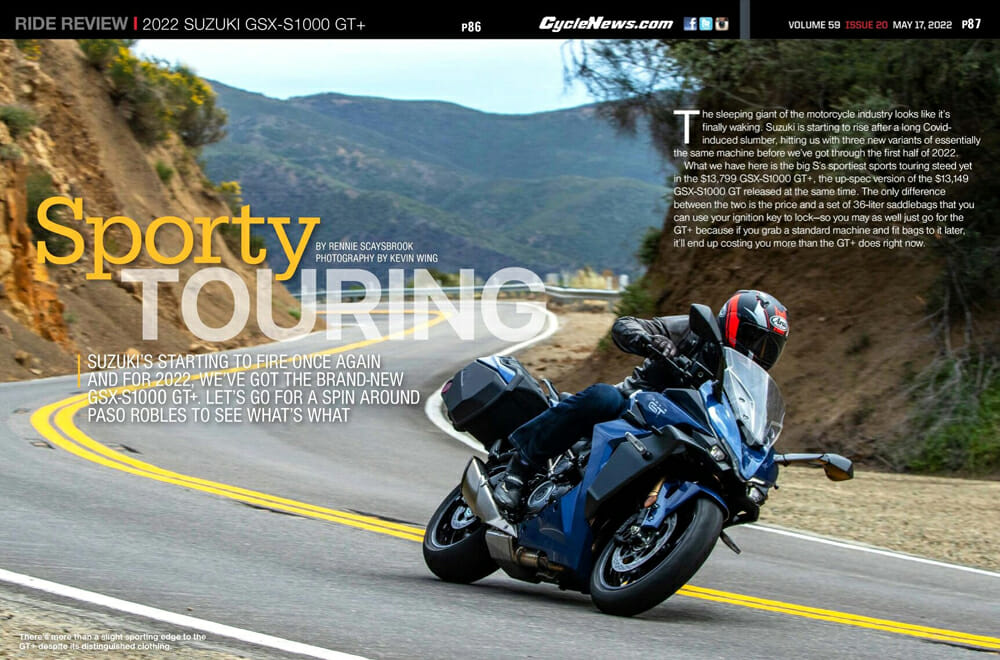Rennie Scaysbrook | May 19, 2022
Suzuki’s starting to fire once again and for 2022, we’ve got the brand-new GSX-S1000 GT+. Let’s go for a spin around Paso Robles to see what’s what.
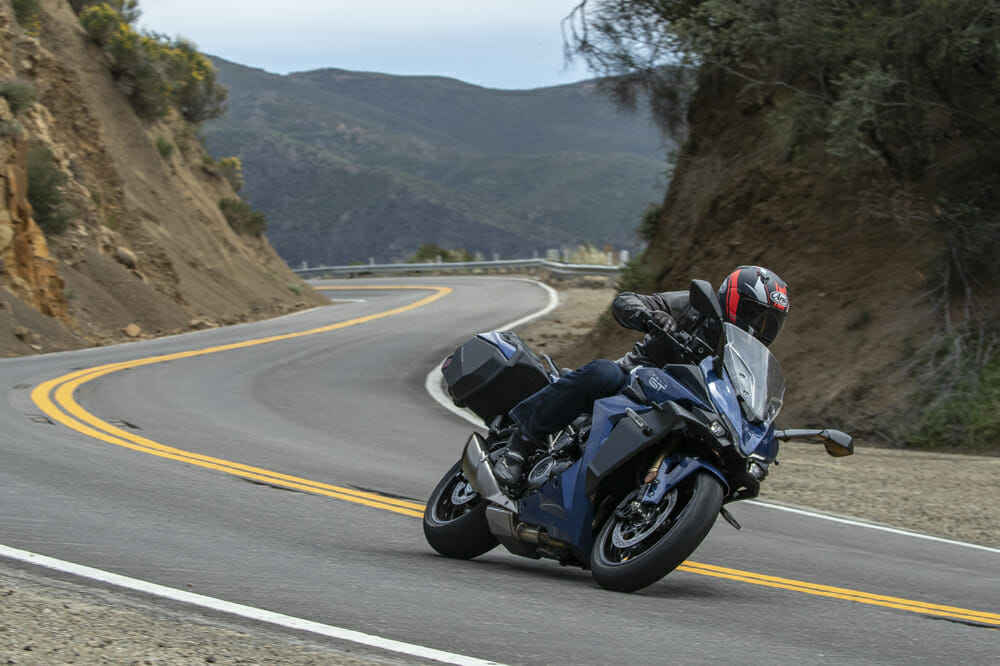 There’s more than a slight sporting edge to the GT+ despite its distinguished clothing.
There’s more than a slight sporting edge to the GT+ despite its distinguished clothing.
The sleeping giant of the motorcycle industry looks like it’s finally waking. Suzuki is starting to rise after a long Covid-induced slumber, hitting us with three new variants of essentially the same machine before we’ve got through the first half of 2022.
What we have here is the big S’s sportiest sports touring steed yet in the $13,799 GSX-S1000 GT+, the up-spec version of the $13,149 GSX-S1000 GT released at the same time. The only difference between the two is the price and a set of 27.5-liter saddlebags that you can use your ignition key to lock—so you may as well just go for the GT+ because if you grab a standard machine and fit bags to it later, it’ll end up costing you more than the GT+ does right now.
The GT+ and GT are the new sport touring versions of the $11,299 GSX-S1000 that we tested a few weeks ago. As such, you get the same 999cc inline four-cylinder motor, six-speed gearbox mated to that divine quickshifter we waxed on about in the GSX-S review.
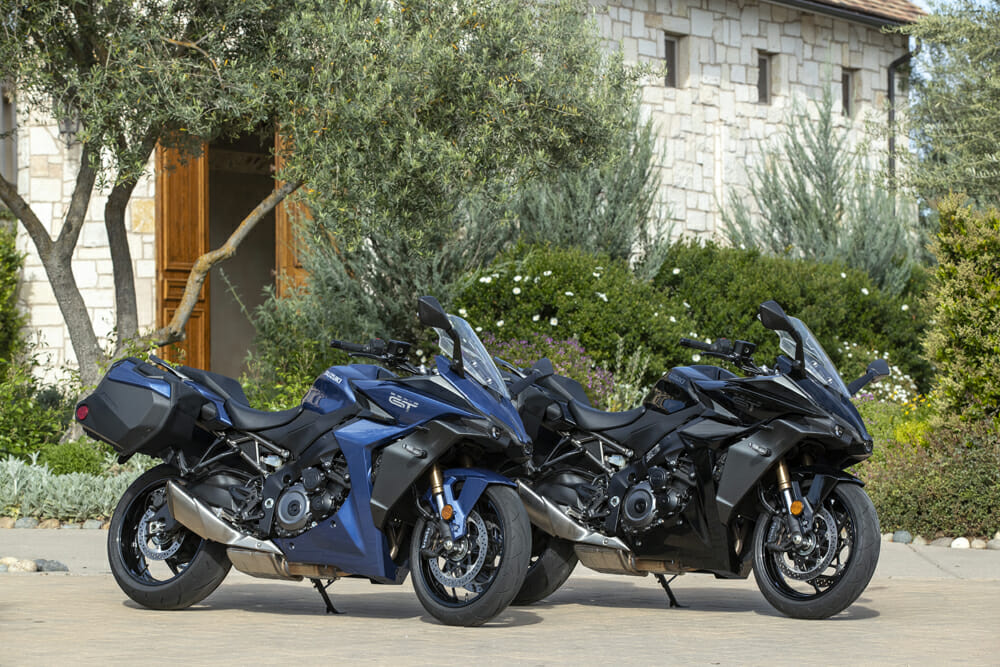 Black and blue, but in a good way.
Black and blue, but in a good way.
You also get the same chassis and the same KYB fully adjustable suspension, although it’s the rider suite of electronics and the ergonomics/bodywork where the differences begin to shine through.
The GT+ is aimed at a real roads sport rider, one who will likely cover much bigger distances than the guy on a GSX-S, so Suzuki’s added a few creature comforts in the GT+ package. Suzuki has spent a huge amount of money and hours in the wind tunnel to create the slipperiest shape possible while still making for ergonomics that won’t have the rider screaming blue murder after an afternoon onboard. There are many intricate cut outs in the fairing, front guard, and windscreen to reduce the amount of air that reaches the rider. The windscreen is of particular note as its curved shape and folded edges are designed to deflect that air that would normally smack into the rider’s shoulders at speed.
After having to make an emergency dash back to So Cal and thus spending the best part of 300 miles on the freeway, this little addition to the aero was a very welcome one for me. The ride is quiet and unruffled at highway speeds, although I’d probably have gone for the optional 70mm higher screen if I had the chance.
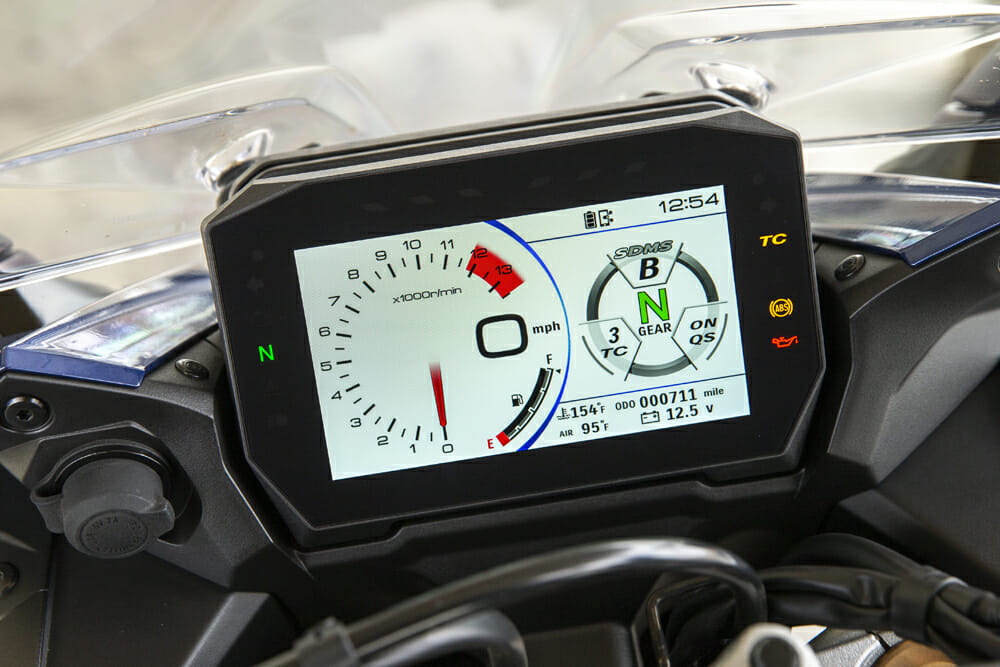 Thank the Lord! Suzuki’s given us a proper dash on the GT+.
Thank the Lord! Suzuki’s given us a proper dash on the GT+.
At 31.9 inches, the seat height is right in the middle for most riders out there, and the seat itself is quite hard so you will either love it or hate it. Personally, I’m a fan of it as the padding refused to sink after a full day on board in everything from high-speed freeway riding to switchback twisties, and when combined with the wider and higher handlebar compared to the GSX-S, rider comfort was never in question—an important point on any bike, but especially so on a sport tourer.
The GSX-S1000 GT+ is also notable for being the first motorcycle in Suzuki’s history to have a TFT dash. Yes, you read right. The first! I’m so glad Suzuki has finally joined the TFT party, albeit much later than it should have, but I’m even happier the GT and GT+ didn’t get that horrendous Game Boy-style dash Suzuki fitted to the GSX-S.
And Suzuki’s done a good job on it, too. The 6.5-inch dash is not terribly difficult to understand and adjust, probably because it doesn’t have features like an IMU, Cornering ABS, etc. You can easily change between your three riding modes, your five stages of traction control (including Off), and you can disengage your quickshifter if you want. However, that quickshifter is currently one of the best on the market in any category so god knows why you’d want to turn it off.
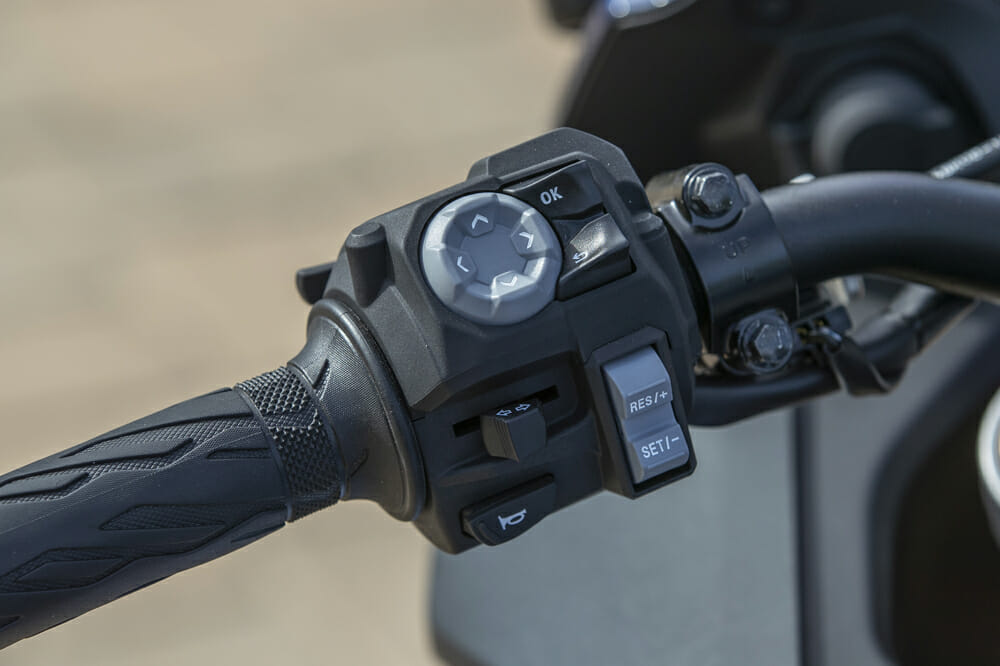 Mission control for the dash is the little grey pad on the left handlebar. Easy as pie to use.
Mission control for the dash is the little grey pad on the left handlebar. Easy as pie to use.
Everything is accessed by the left switch block which also contains—wait for it—cruise control! One of the big omissions of the GSX-S has thankfully not made it through on the GT and GT+, which both come standard with the must-have feature of any 1000cc machine these days, regardless of category.
Over the two days on the GT+, cruise was used extensively, but not up the seemingly endless riding pleasure land between Ojai and Santa Barbara in California, where the GT+ proved it was more than an exercise in aerodynamics and creature comforts.
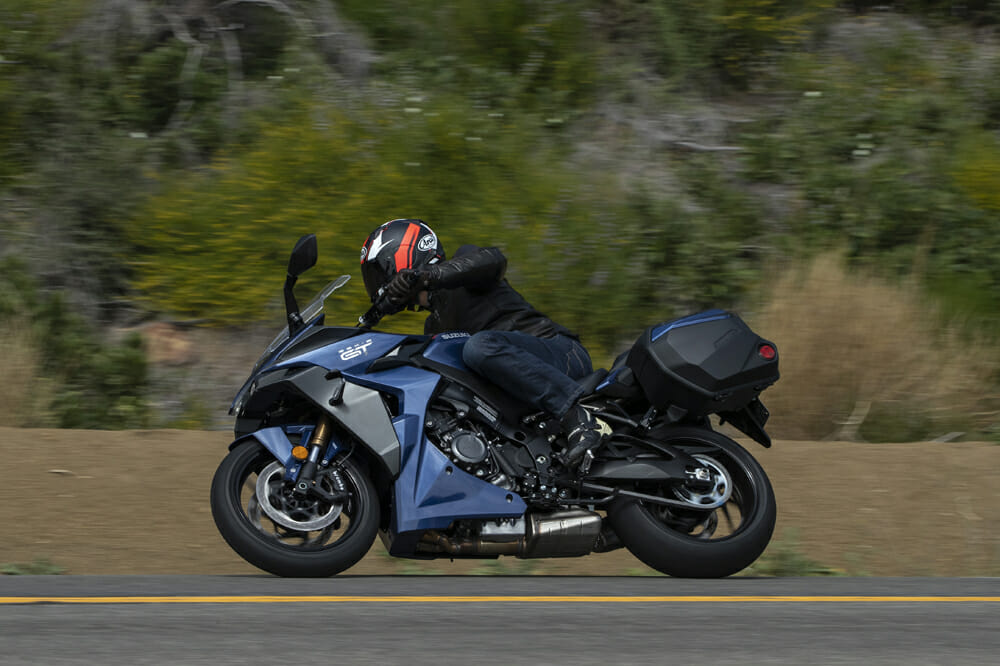 Any legs longer than Rennie’s at 6’1” and the GT+ might get start getting a little cramped.
Any legs longer than Rennie’s at 6’1” and the GT+ might get start getting a little cramped.
Take a closer peep at the GT+ and the name “K5” is never far from your mind. That’s simply due to Suzuki heavily utilizing their most famous superbike as the base for this and the GSX-S naked bike. With 150 horsepower on tap and more midrange punch than a night with Connor McGregor, the GT+ will roar its way through your nearest mountain pass far easier than you’d think. It may look stately with its fancy new mono-focus LED headlights, but this is a superbike at heart, just one a little older and not quite as rage-filled as before.
Yes, it’s far more than just a K5, as Suzuki is at pains to tell us. Suzuki looks at this engine as their small block 350 Chevy, a motor that’s been so useful and versatile that it has transcended generations of different drivers.
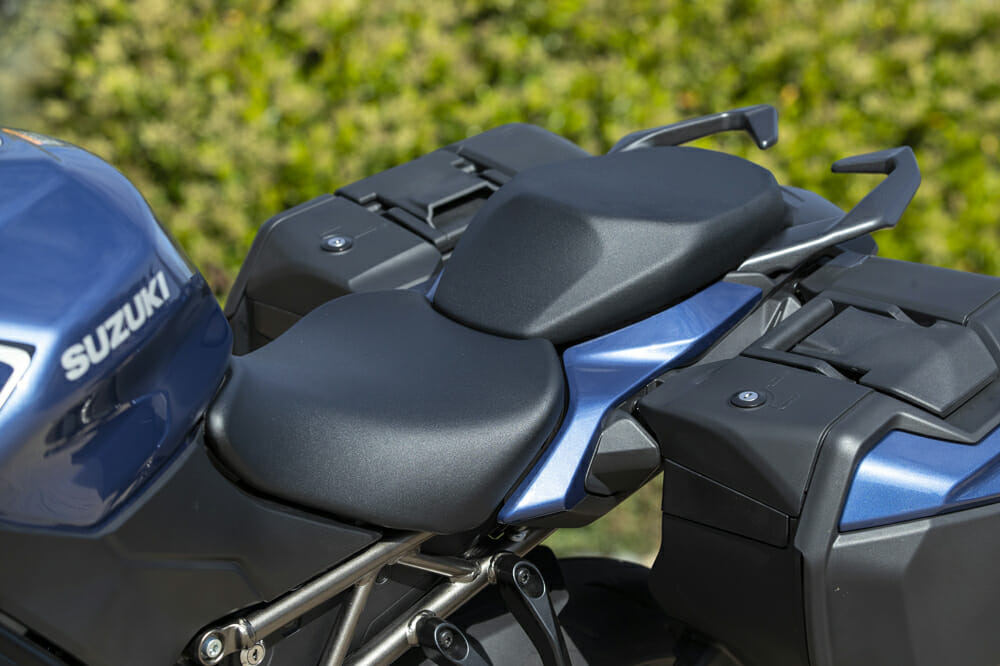 The seats are quite firm, which is both a good and bad thing depending on your point of view.
The seats are quite firm, which is both a good and bad thing depending on your point of view.
The long-stroke K5-derived lump gets everything from new cams, cylinder head and combustion chamber, pistons, throttle bodies, air cleaner and airbox, and, of course, exhaust, but it still feels very much like that beefcake of a K5 motor we all know and love.
One thing I especially like about the GT+ is that it’s uncomplicated in everything from electronics to suspension and brakes and the motor. There are so many bikes on the market that flood you with choice to the point of information overload—if that’s your deal, fair game—but the GT+ still has that riding first, everything else second mentality to it, which in this day of more, more, more, is quite refreshing.
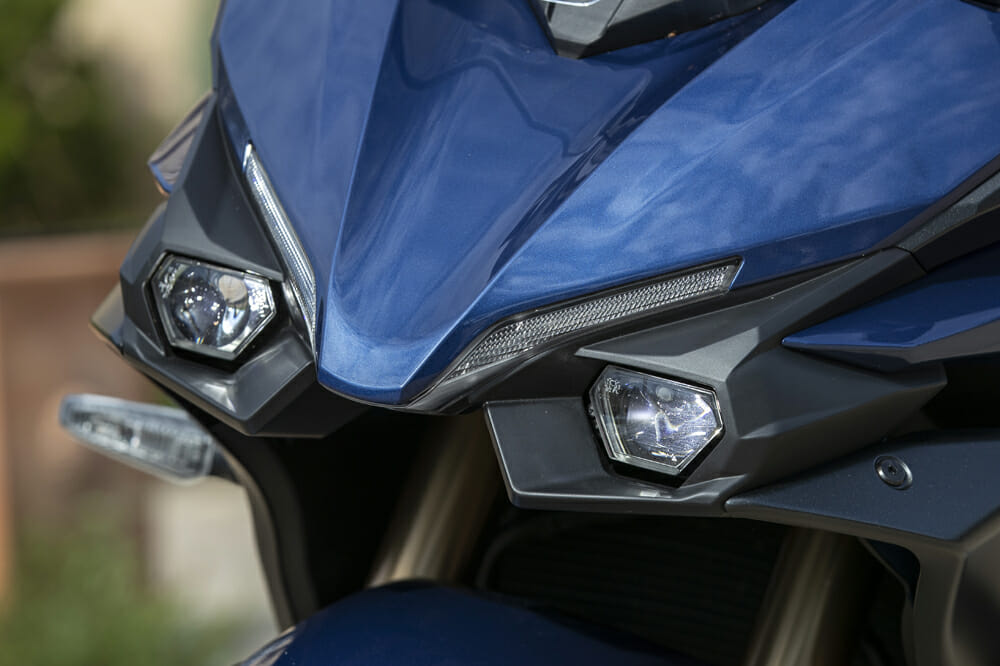 Those mono-focus LEDs look awesome and pump out plenty of light.
Those mono-focus LEDs look awesome and pump out plenty of light.
That uncomplicated nature is evident in the ride, as the conventional suspension (no electronics here) give the rider a nice, tangible feel to what’s going on beneath him/her. Some may lament the fact you can’t harden or soften the suspension at the push of a button, but this would be a bigger issue if the GT+’s suspension was rubbish—which it isn’t. Over two days, I progressively slowed down front and rear rebound but that was only for times when I was giving the GT+ a bit of a shake. For the majority of the time, the standard settings prescribed by KYB are fine.
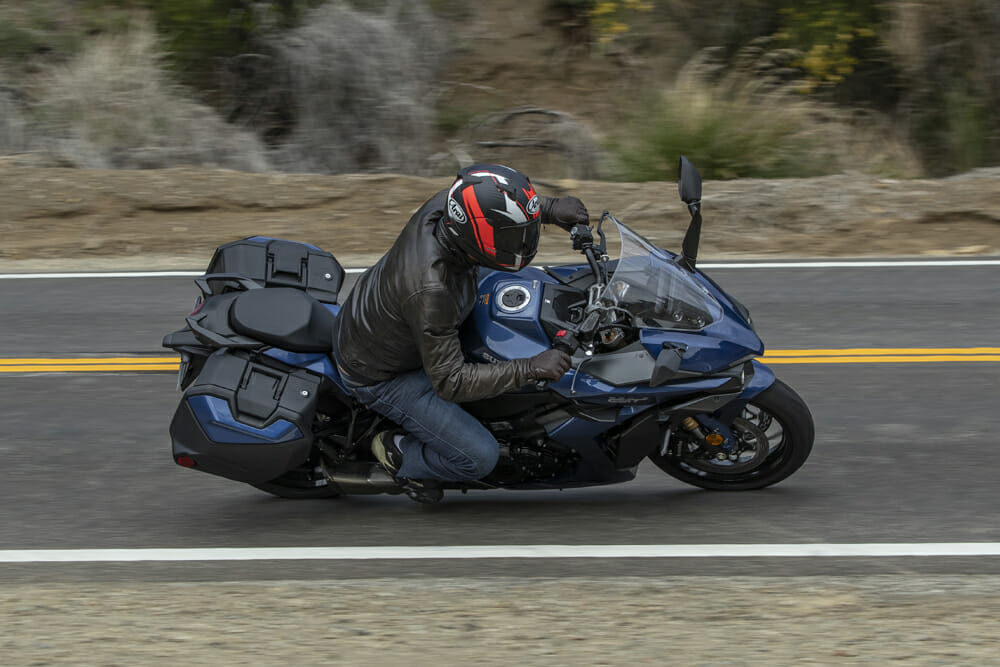 High handlebars make for an ultra-maneuverable machine in the twisties.
High handlebars make for an ultra-maneuverable machine in the twisties.
My only gripe was I thought the brake performance was lacking somewhat. The initial bite I was looking for was conspicuously absent, and only after a good squeeze did the braking force come rushing in. The master-cylinder on all three of the GSX-S/GT/GT+ is pretty old, and perhaps Suzuki could look at a radial master-cylinder to improve power and feel at the lever.
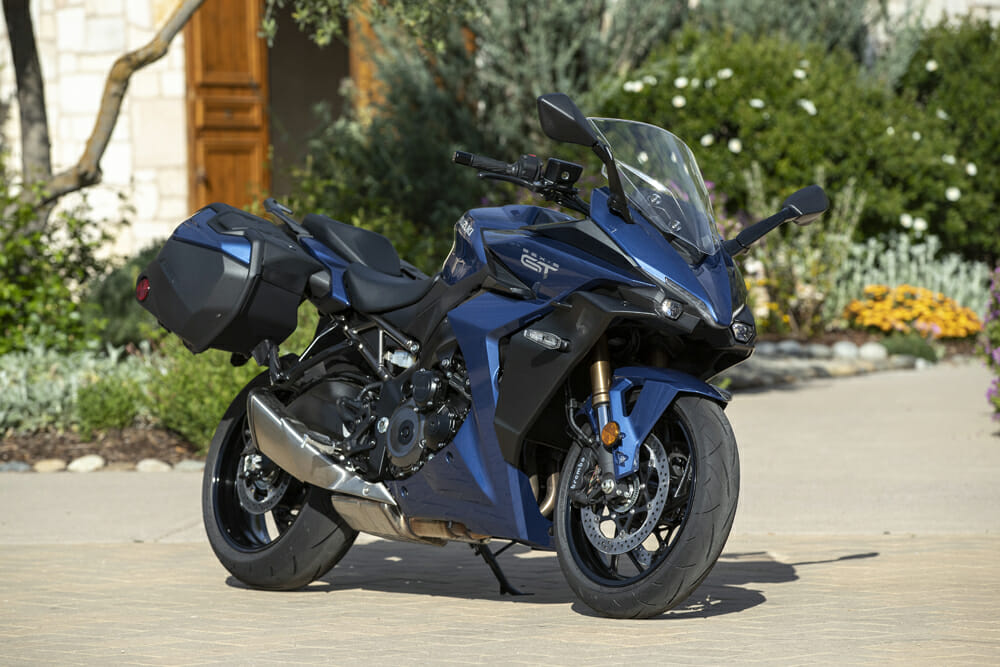 Gotta say, we’re really digging the GT+’s look right now.
Gotta say, we’re really digging the GT+’s look right now.
Overall, however, I was very impressed with the GSX-S1000 GT+. This is the kind of bike Suzuki should have built a long time ago (I still find it remarkable this is the first Suzuki with a TFT dash), and considering the price of $13,149, I don’t think Suzuki will have any problems selling these things real quick. CN
VIDEO | 2022 Suzuki GSX-S1000 GT+ First Ride
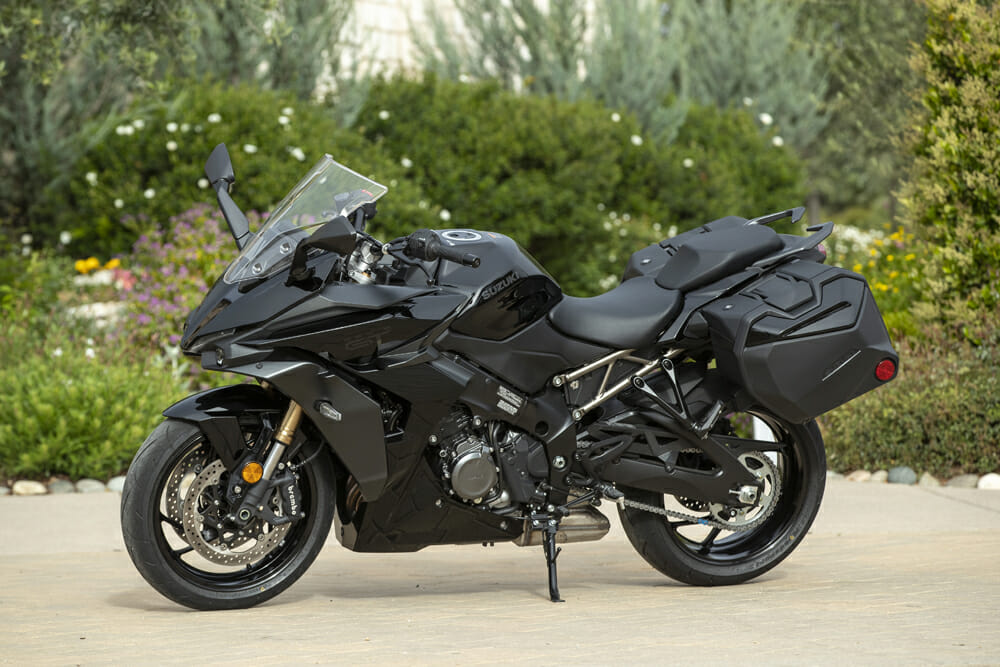
2022 Suzuki GSX-S1000 GT+ Specifications
| MSRP: |
$13,149 |
| Engine: |
4-stroke, 4-cylinder |
| Valvetrain: |
DOHC, 8-valve |
| Cooling System: |
Liquid |
| Power: |
149 hp at 11,000 rpm |
| Torque: |
78 lb-ft at 9250 rpm |
| Displacement: |
999cc |
| Bore x stroke: |
73.4 x 59mm |
| Compression ratio: |
12.2:1 |
| Fuel system: |
EFI, 4 x 40mm throttle bodies |
| Exhaust: |
4-2-1 |
| Transmission: |
6-speed |
| Chassis: |
Aluminum twin-spar |
| Front suspension: |
KYB fork, fully adjustable |
| Rear suspension: |
KYB shock, adjustable rebound damping and preload |
| Front brake: |
Brembo Monobloc 4-piston, radially mounted caliper, dual 310mm discs, ABS |
| Rear brake: |
Nissin 2-piston, fixed caliper, 240mm disc, ABS |
| Front tire: |
120/70 ZR17 in. |
| Rear tire: |
190/50 ZR17 in. |
| Wheelbase: |
57.5 in |
| Seat height: |
31.9 in. |
| Fuel capacity: |
5.0 gal. |
| Weight (curb, claimed): |
498 lbs. |
| Color: |
Glass Sparkle Black/Metallic Reflective Blue |
